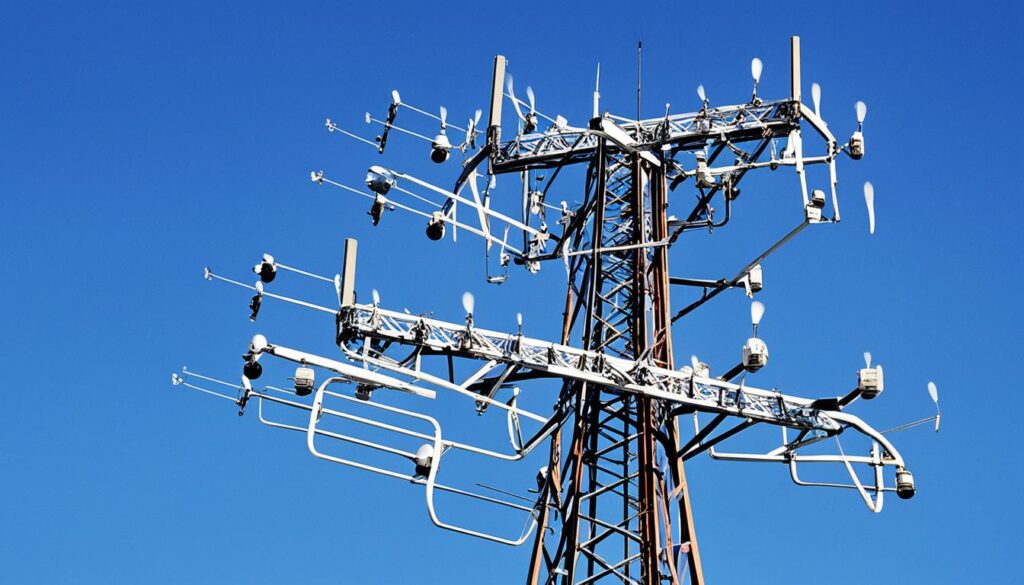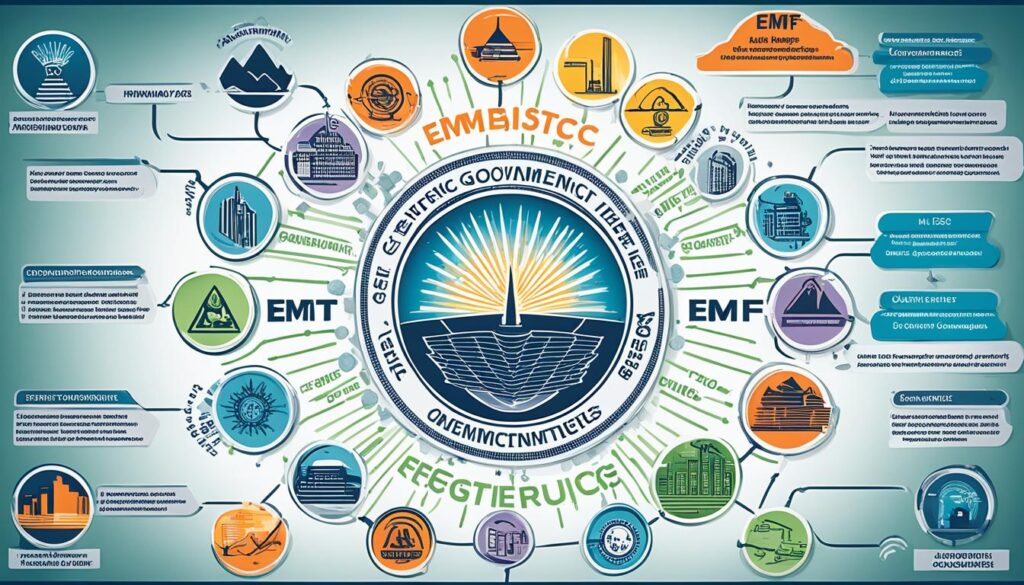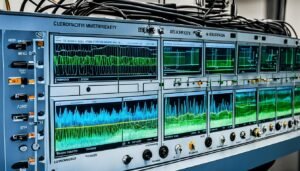Disclosure: This Post Contains Affiliate Links; We earn a commission on purchases.
The regulation of electromagnetic field (EMF) exposure is a critical aspect of ensuring public safety. In the United States, government agencies such as the Federal Communications Commission (FCC) have a vital role in overseeing and implementing EMF regulations. These regulations are aimed at limiting the potential health risks associated with EMF exposure, particularly from devices and equipment that emit electromagnetic radiation.
Government agencies like the FCC evaluate the effect of emissions from FCC-regulated transmitters on the human environment. Through their Rules and Regulations, the FCC sets maximum permissible exposure limits for field strength, power density, and specific absorption rates (SAR) for devices. These guidelines help ensure that devices and equipment operating within specified frequency ranges meet the necessary safety standards.
The FCC’s role extends beyond setting standards. They also provide information and answers to inquiries regarding RF safety, as part of their RF Safety Program. This program serves as a valuable resource for individuals seeking guidance on RF safety and compliance with EMF regulations.
Key Takeaways:
- Government agencies, like the FCC, play a crucial role in regulating EMF exposure in the United States.
- The FCC sets maximum permissible exposure limits for field strength, power density, and specific absorption rates.
- The FCC’s RF Safety Program provides information and guidance on RF safety and compliance with EMF regulations.
- EMF regulations aim to protect public health by limiting potential health risks associated with EMF exposure.
- Government agencies continuously monitor and update EMF regulations based on the latest scientific evidence and expert opinions.
FCC Policy and Standards for EMF Exposure
The Federal Communications Commission (FCC) plays a critical role in evaluating the impact of emissions from FCC-regulated transmitters on the environment, as mandated by the National Environmental Policy Act. To ensure public safety, the FCC has adopted Maximum Permissible Exposure limits for field strength and power density for transmitters operating at frequencies ranging from 300 kHz to 100 GHz.
These exposure limits are based on recommendations provided by authoritative organizations such as the National Council on Radiation Protection and Measurements (NCRP), the American National Standards Institute (ANSI), and the Institute of Electrical and Electronics Engineers (IEEE). By leveraging the expertise of these organizations, the FCC ensures that its policies and standards align with the latest scientific research on electromagnetic field (EMF) exposure.
The FCC’s requirements for EMF exposure are detailed in Parts 1 and 2 of the FCC’s Rules and Regulations. These regulations outline the specific guidelines and parameters for maintaining safe levels of EMF radiation. In addition, the FCC has established specific absorption rate (SAR) limits for devices operating in close proximity to the human body. These SAR limits are based on guidelines set forth in the ANSI/IEEE C95.1-1992 standard.
To address common concerns and provide further information on RF electromagnetic fields and safety, the FCC offers an RF Safety FAQ on their website. This resource answers frequently asked questions related to RF safety, helping individuals understand potential hazards and protective measures.
By establishing policy and standards for EMF exposure, the FCC plays a vital role in safeguarding public health and ensuring compliance with necessary regulations. Through collaboration with esteemed organizations and the provision of informative resources, the FCC remains committed to promoting RF safety and protecting individuals from the potential risks associated with EMF exposure.
Recent Updates in FCC’s RF Safety Rules
The Federal Communications Commission (FCC) continually reviews and updates its RF Safety Rules to ensure the implementation of the National Environmental Policy Act (NEPA) requirements related to radio frequency (RF) emissions from radio transmitters. These updates are crucial to safeguarding public health and maintaining compliance with RF exposure limits.
In recent developments, the FCC has closed ET Docket No. 13-84 and taken significant actions to enhance RF safety. This includes adopting a Report and Order aimed at maintaining the existing RF exposure limits based on the best available scientific evidence. The FCC has also issued a Memorandum Opinion and Order to provide flexibility for licensees in establishing compliance with RF exposure limits.
Additionally, the FCC has issued a Notice of Proposed Rulemaking in ET Docket No. 19-226, which seeks to consider additional limits for localized RF exposure and associated methodology for portable devices and wireless power transfer equipment. These proposed rules aim to mitigate the risk of excess exposure and ensure the safety of individuals in proximity to RF-emitting devices.
“The FCC’s recent actions demonstrate their commitment to protecting public health and safety by updating RF Safety Rules in response to advancements in technology and relevant scientific research.” – Expert in RF Safety Regulations
The FCC’s focus on maintaining compliance with RF exposure limits and incorporating new methodologies reflects their dedication to protecting the public from potential health risks associated with RF emissions. By carefully evaluating the best available scientific evidence, the FCC ensures that regulations are informed by the latest research and expert opinions.
Through these recent updates, the FCC strives to strike a balance between enabling technological advancements and safeguarding public health. By considering additional limits for localized RF exposure and embracing advancements in portable devices and wireless power transfer equipment, the FCC remains at the forefront of RF safety regulation.
The FCC’s commitment to ongoing updates and improvements in RF Safety Rules underscores the importance of adapting regulations to align with scientific advancements and evolving technologies. By staying ahead of the curve, the FCC can effectively address public concerns and uphold the highest standards of RF safety.

RF Safety Rules Advancements and Procedures
In 2013, the Federal Communications Commission (FCC) initiated a comprehensive review of the rules pertaining to the implementation of the National Environmental Policy Act (NEPA) requirements related to radio frequency (RF) emissions from radio transmitters. This review aimed to ensure the soundness of the FCC’s regulations and policies concerning RF exposure.
As part of this review, the FCC issued a series of important documents in ET Docket No. 03-137, showcasing advancements in RF safety rules and the procedures surrounding their implementation.
Report and Order
The FCC’s Report and Order, released in the context of ET Docket No. 03-137, specifically addressed technical and semantic issues in the existing RF safety rules. By clarifying and refining the language used in the regulations, the Report and Order aimed to enhance understanding and compliance.
Further Notice of Proposed Rulemaking
The Further Notice of Proposed Rulemaking, also part of ET Docket No. 03-137, proposed additional updates and revisions to the RF safety rules. This notice sought to gather public input and elicit comments on the need for reassessing RF exposure limits and related policies. By actively engaging stakeholders and members of the public, the FCC aimed to ensure that future regulatory changes accurately reflected current scientific knowledge and public concerns.
Notice of Inquiry
In the same docket, the FCC also issued a Notice of Inquiry, which sought public comment on the potential need for reassessment of RF exposure limits and policies. The Notice of Inquiry was an essential step in the FCC’s commitment to transparency and fact-based decision-making. By gathering input from a wide range of stakeholders, including qualified expert agencies and organizations, the FCC aimed to continually improve its rules and policies.
The FCC’s dedication to staying abreast of the latest research and soliciting feedback from experts and the public enables them to continually refine their regulatory framework. This ensures that RF safety rules are in line with the best available scientific evidence and address emerging concerns.

Stay tuned for the next section, where we explore the intricacies of RF safety and mobile phones.
RF Safety and Mobile Phones
Cellular telephones play a significant role in our daily lives, but it’s essential to consider their impact on human health and safety. The Federal Communications Commission (FCC) takes this responsibility seriously by implementing regulations that limit the amount of radiofrequency (RF) energy absorbed by users. One crucial aspect of these regulations is the specific absorption rate (SAR) compliance.
The SAR refers to the rate at which the body absorbs RF energy when exposed to a cellular telephone. To protect public health, the FCC has set a limit of 1.6 watts per kilogram (W/kg) for SAR in mobile phones. This limitation ensures that RF emissions remain within safe levels, reducing any potential health risks associated with prolonged exposure.
“The FCC’s SAR limit of 1.6 W/kg for public exposure ensures that RF emissions stay within safe levels, reducing potential health risks.”
When purchasing a mobile phone, it’s essential to consider its SAR compliance. To obtain SAR information for specific devices, you can refer to the FCC’s database using the FCC ID number found on your phone or device. The SAR compliance section of the grant of equipment authorization will specify the SAR values for the device in question.
“Consumers can access SAR information for their mobile phones through the FCC’s database, providing transparency and empowering informed purchasing decisions.”
The FCC also enforces regulations requiring mobile phone manufacturers to provide SAR information for devices authorized since June 2, 2000. By making this information readily available, consumers can make informed choices regarding their mobile phone usage and exposure to RF emissions.
The FCC’s RF Safety Program is dedicated to addressing concerns surrounding the safety of mobile phones and provides valuable information on reducing RF exposure. This program ensures that mobile phone manufacturers meet compliance standards and educates the public on ways to minimize their RF exposure without compromising their connectivity needs.
SAR Compliance Limits for Mobile Phones
| Device | SAR Limit (W/kg) |
|---|---|
| Brand A Model X | 1.3 |
| Brand B Model Y | 1.8 |
| Brand C Model Z | 1.4 |
The table above highlights the SAR compliance limits for a selection of mobile phone models. It is important to note that different devices may have varying SAR values, emphasizing the need for consumers to stay informed about the SAR ratings of their chosen devices.
By adhering to SAR compliance and following the guidance provided by the FCC’s RF Safety Program, individuals can enjoy the convenience of mobile phones while prioritizing their health and safety.
Safety Concerns and RF Emissions from Towers and Antennas
When it comes to ensuring public safety, the Federal Communications Commission (FCC) takes the lead in regulating the safety of wireless and PCS towers, as well as radio and television antennas. These structures emit radiofrequency (RF) emissions, which are subject to exposure limits set by the FCC to protect the public from excessive RF exposure.
The FCC’s regulations play a crucial role in ensuring that towers and antennas comply with these exposure limits. Licensees are provided with guidelines to establish compliance and mitigate any potential risks associated with RF emissions. Additionally, the FCC requires the posting of radiofrequency warning signs in certain cases to provide further awareness of potential exposure.
Over the years, public concerns about the safety of towers and antennas have been addressed through the FCC’s RF Safety Program. This program focuses on providing information, addressing inquiries, and alleviating any concerns related to RF emissions. Through these efforts, the FCC works to ensure that the public is protected from any potential harm associated with RF exposure from these structures.
By closely regulating wireless and PCS towers, as well as radio and television antennas, the FCC plays a pivotal role in safeguarding public health and minimizing the risks associated with RF emissions. The ongoing commitment to maintaining exposure limits and addressing safety concerns demonstrates the FCC’s dedication to ensuring a safe wireless environment for everyone.
Ongoing Research on RF Biological Effects
Ongoing research is being conducted to better understand the potential health effects of RF (radiofrequency) exposure. The Federal Communications Commission (FCC), in collaboration with other federal agencies, closely monitors the latest scientific studies and expert opinions in the field of RF biological effects research. The goal is to ensure that safety guidelines and regulations are based on the best available scientific evidence.
RF exposure guidelines are periodically reviewed and updated to reflect the current knowledge and understanding of the potential health concerns associated with RF radiation. This ongoing research enables the FCC to stay informed about any emerging risks and make informed decisions to protect public health.
The FCC’s RF Safety Program plays a crucial role in disseminating information about RF biological effects and addressing public concerns. Through their efforts, the FCC aims to ensure that safety guidelines and regulations are communicated effectively, providing the public with the necessary information to make informed decisions regarding RF exposure.
“The ongoing research on RF biological effects is vital to our understanding of the potential health risks associated with RF exposure. By staying updated on the latest scientific studies, the FCC can continue to develop and enforce safety guidelines that prioritize public health and well-being.”
Stay Informed: FCC’s RF Safety Program
The FCC’s RF Safety Program is dedicated to ensuring that individuals have access to accurate information and resources regarding RF exposure. The program addresses common concerns and provides guidance on safety measures that individuals can take to minimize their exposure to RF radiation.
The FCC’s RF Safety Program website offers a wealth of information, including frequently asked questions (FAQs), fact sheets, and educational materials. It serves as a valuable resource for anyone seeking to educate themselves about RF biological effects and the FCC’s role in promoting safety guidelines.
For those with specific questions or concerns, the FCC encourages individuals to reach out to their Consumer and Governmental Affairs Bureau, which is responsible for responding to inquiries related to RF safety.
Ongoing RF Biological Effects Research Studies
| Study | Objective | Findings |
|---|---|---|
| Study 1 | To assess the impact of long-term RF exposure on human health | Preliminary findings suggest a potential link between RF exposure and certain health conditions |
| Study 2 | To investigate the effects of RF radiation on cellular function and DNA damage | Indications of cellular changes and DNA damage associated with RF exposure |
| Study 3 | To examine the potential cognitive and behavioral effects of RF radiation | Some evidence suggests a correlation between RF exposure and cognitive impairments |
| Study 4 | To assess the reproductive effects of RF radiation on animal models | Preliminary results show potential reproductive abnormalities in animals exposed to RF radiation |
Please note that these findings are preliminary and further research is needed to establish definitive conclusions.
The ongoing research on RF biological effects reinforces the importance of staying informed and following safety guidelines recommended by the FCC. By keeping up-to-date with the latest research and understanding the potential risks associated with RF exposure, individuals can make informed decisions to protect their health and well-being.
Conclusion
Government agencies, particularly the Federal Communications Commission (FCC), play a crucial role in regulating and ensuring public safety in relation to electromagnetic field (EMF) exposure. The FCC’s RF Safety Program sets standards, monitors compliance, and addresses concerns related to RF exposure. Through their regulations and guidelines, government agencies like the FCC aim to protect public health and ensure compliance with EMF safety laws.
Ongoing research and advancements in RF safety rules contribute to a better understanding of the potential health effects of RF energy and the development of effective regulatory measures. By staying up-to-date with the latest scientific studies and expert opinions, the FCC and other federal agencies are able to adapt safety guidelines and regulations to reflect the current knowledge on RF exposure and its potential health effects.
With the continuous efforts of government agencies, it is possible to strike a balance between the advancements in wireless technology and the protection of public health. By upholding compliance standards and prioritizing public safety, government agencies like the FCC demonstrate their commitment to regulating EMF exposure and ensuring the well-being of the population.
Source Links
- https://www.fcc.gov/general/radio-frequency-safety-0
- https://www.fra.dot.gov/necfuture/pdfs/tier1_deis/appendix/app_e17.pdf
- https://www.fcc.gov/engineering-technology/electromagnetic-compatibility-division/radio-frequency-safety/faq/rf-safety

Subscribe to Our Newsletter










